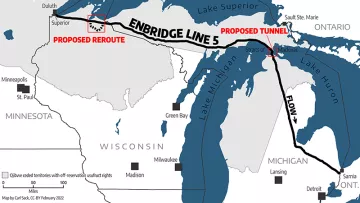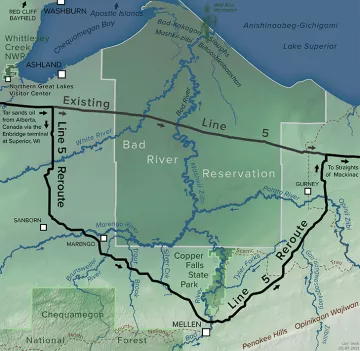
Currently, Enbridge is operating Line 5 illegally on the Reservation of the Bad River Band of Lake Superior Chippewa, and they have been for more than a decade. The Band has resolved not to renew the easements that allow Enbridge to operate on some parcels of land on their Reservation, and has directed Enbridge to remove the pipeline from their lands and watershed. In 2019, they sued Enbridge, and last year, a federal judge ordered Enbridge to remove the pipeline from Bad River’s lands by June 2026. This shut down order is a huge deal, and it’s not soon enough. The natural movement of the Bad River is eroding river banks, bringing the pipeline dangerously close to exposure and potential rupture, which would devastate the area.
Both Bad River and Enbridge have appealed the court’s decision, and in February of this year presented oral arguments in front of the 7th Circuit Court of Appeals in Chicago. As of the writing of this article, no decision has been made.
But the story doesn’t stop here: Enbridge is pushing forward with a project to expand Line 5 around Bad River’s Reservation, endangering an even broader area in order to keep pumping oil that’s ultimately intensifying the climate crisis.

With Line 5, Enbridge poses a threat to our climate, puts us at constant risk of an oil spill and endangers Tribal treaty rights. Their proposed Line 5 reroute jeopardizes waters through construction. When Enbridge rushed through construction of the Line 3 replacement pipeline in Minnesota, they punctured aquifers that have leaked hundreds of millions of gallons of water, and released harmful drilling fluids—and they plan to use the same processes and contractor in Wisconsin.
Eleven Ojibwe tribes, including Bad River, reserve hunting, fishing and gathering rights through treaties with the U.S. government. The 1842 Treaty of La Pointe reserves these rights where Enbridge has proposed the Line 5 reroute, and the company’s construction practices and the constant threat of a spill put these rights in danger.
For countless reasons, this reroute is dangerous, and we need to be prioritizing moving away from fossil fuels, not focusing on extending their lifetime. Enbridge has applied for permits from the Wisconsin Department of Natural Resources and the U.S. Army Corps of Engineers. The company is awaiting a response while the agencies process and respond to the tens of thousands of comments submitted by the public that overwhelmingly oppose Line 5.
What can you do now? Here are two of the major actions we’re pushing in our efforts to protect climate, waters and treaty rights:
- Call your representatives and ask them to support a thorough environmental review at the Army Corps.
- Call President Biden and ask him to stop Line 5 by revoking the presidential permit that allows it to operate.
Look up contact information for both of the actions above at https://www.usa.gov/elected-officials/
Check out our latest action at sc.org/Line5WI
Want to get involved with our organizing efforts and help expand this fight? Email jadine.sonoda@sierraclub.org to hear more about our volunteer team. We’d love to have you join!